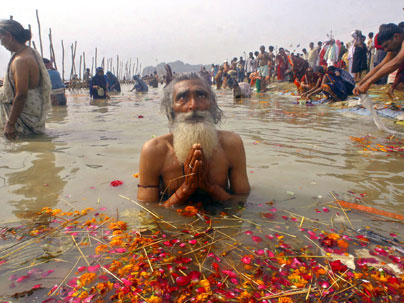Dehradun : Even as the high-profile meeting of the National Ganga River Basin Authority, chaired by none other than Prime Minister Manmohan Singh himself, was able to side track the issue from hydel projects coming up on the Bhagirathi and Alaknanda (that meet at Devprayag to form the Ganga) in Uttarakhand to pollution in the sacred river, little was said on the garbage left behind by crores of pilgrims to the four dhams of Badrinath, Kedarnath, Gangotri and Yamnotri, located at heights ranging from 3100 to 3600 metres above sea level.
Due to commence later this month, the char dham yatra, as the pilgrimage to the four important shrines in the Uttarakhand is popularly known, draws over a crore of pilgrims from various parts of the country.
This coupled with lakhs of visitors converging in the higher reached of this small mountain state, including the popular Valley of Flowers, the number of pilgrims and tourists in the region reaches a mind boggling two crore people.
And though due concern has been expressed at various quarters of the pollutants and garbage being spilled into the Ganga in the states of the plains, no one has uttered a word of the garbage that this huge number of people leave behind in the higher mountain reaches along the catchment areas of the rivers, which ultimately is carried into the Ganga and its major and minor tributaries located in the area.
According to a rough estimate, on an average about three tones of garbage is dumped by the pilgrims who visit the four religious shrines mentioned above.
But neither has the management of the shrines or the Badrinath-Kedarnath Managing Committee, nor the Uttarakhand government or for that matter the centre done anything for solid waste management at these religious townships that have grown over the years.
The garbage is left to be carried by the rains to the rivers. Now this is just the pilgrims converging to the four major shrines.
Add to them the number of tourists visiting the Valley of Flowers and trekkers to the various glaciers, including the Pindari glaciers and other important and popular trekking routes in Uttarakhand.
Authorities at the valley of Flowers claimed that on an average a tourist visiting the valley generates about 170 gms of garbage which is left behind in the serene valley, that is slowly losing its natural beauty.
The reason is that the garbage that is left behind, mostly comprising of non-biodegradable plastic water, juice and cold drink bottles and plastic carry bags are carried by high velocity winds to the interiors of the valley, where they stop the natural regeneration of the wild flowers.
The vibrant green hill sides are slowly giving way to littered garbage that is becoming an eye sore. Though locals and some NGOs pool in their efforts to cleanse these areas at the heights of the garbage left behind by tourists and pilgrims alike, but their efforts literally go a begging as the task is so voluminous.
However, officials of the state government said that a Rs 800 crore programme financed by the Asian Development Bank was underway for solid waste management projects in 28 cities of Uttarakhand, which includes all the four religious townships.
The survey for the sites of the projects have started and should they go as scheduled the programme will be completed by 2016.
A journalist with over 40 years of experience, Jagdish Bhatt was Editor, Hill Post (Uttarakhand).
Jagdish had worked with India’s leading English dailies, which include Times of India, Indian Express, Pioneer and several other reputed publications. A highly acclaimed journalist, he was a recipient of many awards
Jagdish Bhatt, aged 72, breathed his last on 28th August 2021 at his Dehradun residence.




